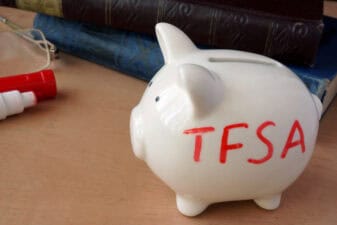In the first two installments of this new series of articles, we looked at two key steps toward financial independence: paying off debt and, once that is accomplished, applying the resulting surplus to savings and, ultimately, towards long-term investments.
Somewhere near the transition between those two events, we need to tackle emergency savings, normally defined as highly liquid but low-yielding cash or cash equivalents sufficient to meet three to six months of daily living expenses.
Prepare for anything
You could even argue that an emergency cash cushion should take precedence over debt elimination, saving, and investing. The fact is, studies show that in Canada 46% of families are just $200 away from suffering from a financial emergency, while 27% of Americans would have to sell something to meet an unexpected financial need of a mere $400.
Assuming you are relatively early in the financial life cycle, you probably have rent or a mortgage to pay every month. That expense doesn’t go away, nor do the other expenses needed to sustain life, such as food, utilities, transportation, and all the rest.
One of those expenses may well be payment on debt if you’re still owing on credit cards, student loans, car loans, or even the mortgage. That’s why we began this series on the need to eliminate all forms of debt. The bonus is that once you do, you may not need quite so hefty an emergency cushion. Conversely, if you have jettisoned debts and are somewhere down the road to saving and investing, those very savings can serve as the ultimate safety net.
Normally, you shouldn’t regard RRSP investments as an emergency cushion, since you’ll have to pay tax to access the funds. Most people will try to keep relatively high cash balances in their chequing accounts that can serve as a cushion, instead. Although, typically, these accounts pay next to nothing in interest income.
Our family likes to keep about $10,000 handy this way, but beyond that, we’ll ask the bank to reinvest in such liquid reserves as short-term or redeemable GICs that may pay somewhere between 1% and 2% per annum.
Another good place to “park” such funds is a High Interest Savings Account (HISA).
Save it if ya got it
As the name suggests, HISAs pay high amounts of interest, usually more than 2%. According to this source, several pay more than that.
As of mid-2019, EQ Bank was paying 2.3%, Motus Bank was up to 2.5%, Tangerine was offering a promotional rate of 2.75%, Motive Financial was paying 2.8%, Wealth One Bank of Canada was paying 2.3%, and WealthSimple was paying 2%. Those are pretty nice returns for liquid cash cushions!
Because most HISAs have no penalties if you do need the funds, they make a good place for emergency savings. If the HISA provider is also a member of the Canada Deposit Insurance Corp. (CDIC), then $100,000 will be protected. If you have more than that, spread it among multiple institutions. Although, it’s hard to imagine the need for an emergency fund that large. Additionally, deposits at credit unions are insured provincially and usually cover the customer’s full deposit.
Taking taxes into consideration
One downside here is that if the HISAs are non-registered, this interest will be fully taxable at your top marginal rate. If that’s the case, then consider the Tax-Free Savings Account (TFSA), which can be a fine source of emergency savings. As the name suggests, and unlike an RRSP, there is no tax penalty to access the funds.
Odds are, your TFSA investments will be invested in longer-term equity and fixed-income vehicles, but there’s no reason a fixed-income ETF couldn’t be liquidated in the event of a true financial emergency. Just remember to replace the amount you withdrew the following calendar year so as not to lose the valuable tax break that the TFSA provides. Since it would have been an emergency, the need to tap TFSA funds shouldn’t happen too often.
A “guaranteed” savings option
Another vehicle for emerging savings can be GICs, or Guaranteed Investment Certificates. Remember, though, that GICs most commonly require you to lock up your money for anywhere between two and five years, even though they don’t pay significantly more than HISAs, if at all. Cashable or Redeemable GICs make more sense for emergency funds, but they will pay less interest than non-redeemable GICs, and probably less than most HISAs. If you can get 1.5-1.8%, you’ll be doing well.
According to RateHub.ca, the typical cashable GIC is a one-year term with either a 30- or 90-day closed period, during which your investment is locked in. After the closed period, the GIC can be cashed out at any time without penalty. That’s not ideal since emergencies, by definition, require almost immediate access to funds if and when they occur. I’d regard them as more appropriate for non-emergency savings, where you know a big expense is coming up, such as buying a new car, doing a renovation or something similar. In those cases, you don’t want to commit funds to the stock market.
Redeemable GICs are offered for a variety of terms and may be redeemed prior to maturity, according to RateHub. Check with the supplier on terms and restrictions, as they can vary quite a bit.
The best of the rest
These days, another alternative is money market mutual funds or, if you can find them, money market ETFs or short-term bond ETFs. Many don’t pay much, but a handful have decent yields, like iShares Premium Money Market ETF (TSX:CMR), which has a 12-month trailing yield of 1.54% and a distribution yield of 1.22%. Or you could consider Purpose High Interest Savings ETF (TSX:PSA), which yields 2.15%.
Yet another alternative are treasury bills, or T-bills, usually issued by the federal or provincial governments. These are high-quality debt securities with a term under one year. Most of the banks also offer T-bill funds (such as the RBC Canadian T-Bill Fund). Just be aware that you may have to commit to at least $5,000 to buy a T-bill, and you may be penalized for taking the money out early. Commercial paper may pay a bit more than a T-bill and face the same $5,000 minimum purchase and early redemption penalty.
Foolish bottom line
By definition, emergency situations are unexpected, and when they do crop up, you’ll need a liquid source of funds that aren’t subject to market fluctuations or early withdrawal penalties.
Don’t expect huge rates of interest, since high liquidity usually means agreeing to less flexibility than you’d want for the main purpose of this fund: emergencies. Any interest you can get should be considered a bonus, but that should be trumped by safety and liquidity.
Lastly, be realistic about how big an emergency fund you need. Beyond a certain point, your money will be working harder in longer-term investments held in RRSPs and TFSAs.








